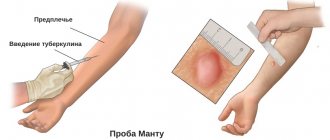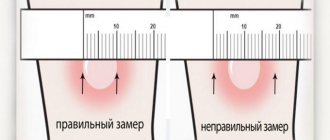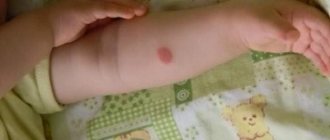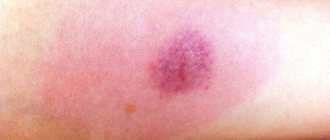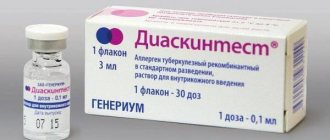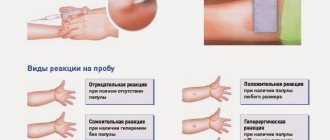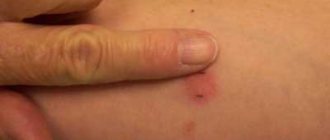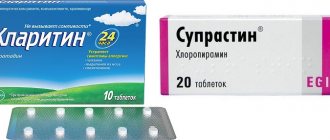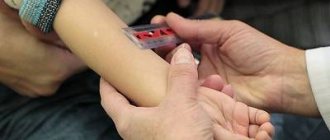Duration of development of reaction to tuberculin administration
The first Mantoux test must be taken as soon as the child turns one year old; a similar procedure is repeated every year.
The test results are carefully recorded in the child’s medical record and compared with previous ones. In particular, doctors pay attention to the size of the papule and the duration of the skin reaction
The Mantoux reaction is a unique response of the body to the introduction of tuberculin, an extract from carrier bacteria, injected into the baby’s forearm. At the injection site, the attraction of T-lymphocytes that have “acquaintance” with Koch’s bacillus begins; they accumulate under the skin, so the growth of the button begins.
After administration of the drug, you need to carefully monitor changes in the papule. An increase of up to 2 mm is normal; swelling of 2 to 4 mm is also not cause for concern, but requires additional consultation.
The growth of a button from 5 to 16 mm is a positive reaction, and should alert parents and doctors; in this case, the child is registered with a phthisiatrician for more careful monitoring. A papule that appears, having a size of 17 mm and above, in most cases indicates a large number of tuberculosis bacteria in the body and possible infection.
Next, the skin reaction should gradually disappear, and normally after a week and a half there should be no traces of the drug administration on the child’s hand.
The duration of the reaction may vary depending on the individual characteristics of the child’s body: sometimes the trace of Mantoux can be completely unnoticeable already on the second or third day, or can persist for more than a week.
However, if nothing bothers the child and the papule itself is not inflamed, not seriously enlarged and noticeably decreases over a short time, then there is no need to worry.
A recent BCG vaccination, which is done to create immunity against tuberculosis pathogens, can also influence the duration of the reaction. The Mantoux test determines the presence of these bacteria in the body, which is expressed in a long-lasting and pronounced skin reaction.
The child himself can provoke a long-term reaction to the Mantoux test if he does not follow the rules of caution. In particular, it is strictly prohibited:
- rub the injection site with a washcloth;
- bathe in hot water, steam papules;
- squeeze out liquid from the papule;
- treat the wound with brilliant green, iodine, peroxide.
Factors influencing the reaction
The accuracy of the Mantoux test depends on many external and internal factors that can cause a false positive result. First of all, you need to take into account the general condition of the child.
Injections should not be administered during any painful condition. This could be a viral disease, exacerbation of chronic pathologies of internal organs, skin diseases, bacterial infections
Particular attention should be paid to temperature readings at the time of the procedure.
If the child has recently been ill, then the test is done at least 1 month later. Many experts believe that false positive results occur more often in children with allergies.
When we talk about annual tests, which are carried out en masse in children's educational institutions, it is important that medical staff follow consistency. It is advisable to carry out this procedure at the same time of year, for example, spring or autumn
It is also recommended to alternate hands every year.
You should also pay attention to the schedule of preventive vaccinations. The Mantoux test is usually done before any vaccinations.
But if you have recently received any vaccination, then you will have to wait 1-2 months
It is very important to ensure proper care of the injection site
Ideally, you don’t need to do anything with it for the first 72 hours, until the result has been measured. The child should not injure his hand, itch, or sweat excessively. Personal hygiene products – creams, soaps, gels – can increase the reaction. As for pure water, by itself it does not affect the reaction in any way. It is forbidden to cover your hand with a plaster or bandage. If we are talking about teenage girls, then their results can be influenced by the phases of the menstrual cycle.
All of the factors described above can give a false positive result, but there are also cases when a child gets a false negative reaction, which is also not good. A negative reaction can be caused by serious problems with the immune system, then the body is simply not able to respond to such irritants. Such cases can occur, for example, with congenital HIV infection. Also, there will be no reaction if tuberculosis infection occurred less than 10 weeks ago. Children under 6 months are not able to adequately respond to tuberculin, so tests begin at 1 year.
The Mantoux reaction may falsely increase due to the psychosomatic state of the baby. After all, it has been scientifically proven that our psyche is capable of influencing the disruption of various processes in the body. Therefore, the parents’ task is to convince the baby that nothing bad will happen to him. It is necessary to create the most comfortable conditions for the manipulation. If a child flatly refuses to give an injection and becomes hysterical, then you need to first calm him down and not try to carry out the procedure by force.
Factors distorting the result
Staging Mantoux requires some preparation, but is not difficult. While compliance with precautions, recommendations, and care features requires much more attention from both medical staff and parents.
The following factors can affect the Mantoux result:
- Testing at the time of any illness of the child or exacerbation of chronic pathology. This group includes allergies, infections, colds, parasites, viruses, epilepsy, gastritis and any other pathology. This also includes individual signs of a cold such as cough, runny nose, and fever of unknown origin. The child must be absolutely healthy. To do this, before Mantoux, the doctor examines the children and analyzes medical records.
- Violation of the injection technique or the permissible dose of the drug, its expiration date or transportation. Tuberculin is administered exclusively subcutaneously. A deeper injection can provoke an allergic reaction and tissue inflammation, further penetration of the substance into the bloodstream and lymph, which sometimes results in extensive inflammation.
- Mantoux is not given during the quarantine period in a child care facility and a month after it.
- Giving any vaccination on the same day as Mantoux or less than a month or two before it can affect the result of the test.
- Psychosomatic diseases or conditions resulting from fear of Mantoux. The doctor and parents should explain to the child the specifics of diagnostics and care of the puncture site. For small children, you can create a play situation.
The result can be distorted not only when the test is taken at the time of illness, but also at certain times after it. Usually a so-called medical withdrawal is given. The period of medical withdrawal after a particular illness differs depending on the specifics of the diagnosis.
After a cold, ARVI, or FLU, it is recommended to wait a month, after chickenpox - six months, after measles - one and a half, up to a year after mononucleosis. Pediatricians recommend considering each case individually and assessing the condition of each child, rather than using general numbers.
It is recommended to take the test annually at approximately the same time and alternating hands. It is allowed to shift the diagnosis for a period noted by the doctor, but then the countdown is carried out from a new point. Frequent Mantoux testing is one of the reasons for a false positive result.
False-positive results in young children are often associated with BCG vaccination or revaccination at an older age. BCG is done in the first days of a child’s life, the first Mantoux test is done at one year. It makes no sense to do it before, since the result will certainly be erroneous due to the immunity formed after the introduction of the vaccine. But in some cases, the same effect persists until the child is two or three years old.
Tuberculin diagnostics - a load on the immune system, tuberculin - an allergen. It is important that at the time of the procedure the body has enough strength to adequately cope with the test. That is, it was not loaded with anything else.
How is it done?
The injection is given intradermally, that is, into the upper layer of the skin, specially lifting the skin with the needle upward. The place where the test is performed is the forearm, usually its middle part.
Why do they do it?
Since the tuberculin test is done in childhood, many parents are interested in the question of why their children are given Mantoux.
Goals:
- Selection of uninfected children who do not have an immune response to tuberculin for the purpose of subsequent vaccination;
- analysis of the dynamics of results over several years, according to which it is possible to reasonably assume the presence of tuberculosis (“Mantoux turn”);
- identification of a pronounced (hyperergic) reaction, which always requires additional tests.
Adults generally do not receive the TB vaccine for a long time (most of us have not been vaccinated since adolescence). Therefore, in adults, the Mantoux reaction is a sensitive and reliable test for the presence of a tuberculosis pathogen in the body.
Preparation
The test is not done during any acute illness. First you need to heal.
The test method does not require any special preparation.
Composition of the drug
The tuberculin test consists of:
- Fragments of tuberculosis bacteria, thermally and chemically processed;
- stabilizer - twin-80;
- preservative – phenol;
- sodium and potassium phosphates;
- sodium chloride
- water.
Is Mantoux harmful?
The test is absolutely harmless.
The main complaints are made about phenol, which is part of the sample. Phenol is indeed a toxin. But its amount in the administered tuberculin test is so small (0.00025 g) that it does not have any effect on health.
Phenol is a natural metabolite: it is formed in tissues as a result of the activity of bacteria in the intestines. This substance is found in many foods. Phenol entering the blood is decomposed in the liver and excreted in the urine. About 0.1-0.15 g of this metabolic phenol is excreted from the body every day. This is several hundred times more than what a person receives with a tuberculin test.
The medical use of phenol in low concentrations is justified.
How often can this be done for a child?
Mantoux is done once a year.
With more frequent testing, an amplification effect is observed: the sensitivity of the immune system to tuberculin increases, resulting in the formation of a false-positive response.
There is no point in testing more than once a year.
how to reduce manta
We visited the “Good Doctor”... later I’ll write our blood and ultrasound results for myself
Dynamics: the liver is unchanged, but because As the child grows, its enlargement becomes smaller, the cervical lymph nodes were 15x6 mm, they became 14x3 mm, I don’t remember the submandibular numbers, but they also decreased, there was still no virus in the blood, hemoglobin is good...
Those. the dynamics are all good and as the doctor promised there was no virus, but there shouldn’t have been any lymph nodes anymore... yes, they have shrunk, but they are there... because of this, she sends us to a hematologist at the regional... it’s scary, of course, she said, that everything will show well, but they must give treatment
The unpleasant thing is that alkaline phosphatase is slightly elevated, you need to drink a choleretic drug - hophytol..
And just vitamins, because... autumn, so as not to get sick)
She said that Timur is a very smart and very cunning boy) and that I spoil him a lot, because... I do everything as he wants, and not as needed, or not as I want... so we need more dad therapy and less mom therapy... I advised him to leave him with his grandmothers... and leave on her own... but how? We are alone here, dad works all day long, so Timik and I are sitting together ((that’s how moms have become...
Regarding food, because... we don’t eat anything except meat and vegetables, she suggested just not giving anything until she’s hungry.. and not like me, she offered porridge, but I refused, and I gave him meat and vegetables for breakfast, lunch, and dinner.. breasts, preferably only for the night and at night, but in general it’s time to finish..
She said that after vaccination she should wait a month, etc. lymph nodes are preserved, it’s better to put it off for now and do it in 1-3 months, don’t rush...
Gums, again sends to the dentist, because of the swelling and blueness on three sides... already where are the molars... we have everything in a crowd..
Weight is normal..
Bottom line. Everything is fine!! Track. appointment in a month, no tests needed, because blood except alkaline phosphatase is ideal ttt.
While we were waiting at the hospital, the people in front of us were a little late at the doctor’s, and we were freed a little earlier, Timik was playing with toys) at home he doesn’t need a big car for a long time, but here it’s so interesting, he ran from one to another and walked with them, little ones I also managed to ride the cars) sat at the table, played with the teapot and cup, “poured” from the teapot into the cup and, vice versa, and treated the pyramid elephant to tea) a big boy (probably 5 years old) sat down next to him, Tim was so surprised and exclaimed “Hey” rolled his eyes and told the boy something, but he didn’t pay attention to us, then we looked from the side at the little girl...
And yet, I was again amazed by the free doctors, they stubbornly want to give us vaccinations, we really can’t put it off, they say, “What are you, so what, what about lymph nodes, there’s nothing wrong with that” and we’ve had them for more than 6 months now …. I don’t know whether we’ll go to ours, after all these thoughts, I actually already want to buy a certificate for annual service in a private one and not think about anything else.. If anything happens after New Year’s, we’ll do this..
Mantoux norm in children - dimensions
Nowadays, the Mantoux reaction is given to all children who go to preschool or school. After all, tuberculosis is a truly terrible disease that is easily transmitted in children's groups. Few parents would want to risk the health of their child. Therefore, in connection with the increasing cases of a positive reaction of the body to a tuberculin test, it is advisable to know the Mantoux norm in children and what should be the size of the spot that remains on the skin after the introduction of weakened bacteria that cause tuberculosis.
What should be the Mantoux diameter in children according to medical standards?
After an injection of tuberculin, the body’s reaction is assessed no earlier than 72 hours later, measuring the size of the resulting papule - a reddened area with compaction that rises above the surface of the skin. In this case, it is necessary to perform a number of manipulations in a certain sequence:
First, the injection site is examined to determine the lack of reaction, the presence of hyperemia and swelling. After this, by careful palpation, the thickness of the skin at the site of tuberculin injection is determined, and only then they begin to record the size of the Mantoux reaction and compare it with the norm. The measurement is carried out only with a transparent ruler and only the size of the compaction is determined. If it is not there, only then the size of the redness around is assessed. Depending on the measurement results obtained, the Mantoux test is calculated:
Depending on the measurement results obtained, the Mantoux test is calculated:
- Negative
if the infiltrate is completely absent or the diameter of the spot from the injection is 0-1 mm. - Doubtful
if the size of the papule is 2-4 mm with a complete absence of compaction, but there is redness around the injection site. - Positive
when the compaction is pronounced. The norm for the size of the Mantoux vaccination in children for a weakly positive reaction is the size of the infiltrate no more than 5-9 mm in diameter. If it is 10-14 mm, the body’s reaction is classified as medium intensity, but with a pronounced papule with hyperemia around the size of 15-16 mm, it is classified as pronounced. - Hyperergic
(in this case, parents need to immediately sound the alarm) if, when measured, the diameter of the infiltrate is 17 mm or more. The condition after the Mantoux reaction is considered especially dangerous, in which the appearance of pustules and tissue necrosis at the injection site is recorded, as well as enlargement of the lymph nodes, regardless of the size of the compaction.
It is also of great importance how much time has passed since the administration of the BCG vaccine
To understand what size Mantoux should be normally, pay attention to the following:
The Mantoux test (reaction) must be done for children annually.
home
Articles
Diagnostics
Loginevskaya Yana Vladimirovna
Pediatrician
29.10.2015
Mantoux test (reaction) is an immunological test for the presence of tuberculosis infection.
When performing the Mantoux test, small doses of tuberculin, an antigen obtained from Mycobacterium tuberculosis, are injected intradermally and the local reaction is assessed.
Why does the size of the papule at the site of tuberculin injection increase in the presence of tuberculosis infection?
Upon contact with any infection or upon administration, the cells of our body’s immune system (lymphocytes) “remember” the microbes and produce antibodies to them. Thus, when the infection is encountered again, existing antibodies contribute to a milder course of the disease and faster recovery.
So, in the presence of tuberculosis or after BCG vaccination, the child’s body contains lymphocytes familiar with this infection. With active tuberculosis, there are more such lymphocytes than in those vaccinated with BCG, therefore the size of the papule is larger.
If the child has never been in contact with a patient with tuberculosis and has not received the BCG vaccine, then the Mantoux reaction will be negative.
In children aged 1-2 years vaccinated with BCG, the Mantoux reaction may be negative, since in some cases immunity develops slowly.
The Mantoux test is performed for the early diagnosis of tuberculosis in children and adolescents and for the selection of children for tuberculosis vaccination. The study is conducted once a year. Patients of the Children's Diagnostic Center can now do a Mantoux test and undergo a comprehensive Diaskintest.
The study must be planned before any vaccinations or 1 month after, because they may affect the outcome of the reaction.
The Mantoux test is contraindicated for:
- skin diseases in the acute stage
- acute diseases
- chronic diseases in the acute stage (including epilepsy, rheumatism, bronchial asthma)
- the presence of quarantine for childhood infections (the Mantoux test is performed immediately after the quarantine is lifted).
The Mantoux reaction is assessed by a specially trained nurse after 72 hours. Until the results are assessed, it is important not to allow the sample site to come into contact with water or other liquids, and not to allow the child to comb the “button.” There is no need to smear the sample site with brilliant green, peroxide, or any other means, or cover the wound with an adhesive plaster. Remember that these effects on the site of tuberculin injection can affect the test result, and this is not necessary for either the patient or the doctor.
If a child suffers from allergies or has severe itching at the site of tuberculin injection (at the site of the test), it is necessary to consult with a pediatrician about the possibility of prescribing antihistamines to the child.
It is important to remember that the Mantoux test is not a vaccination!!!!
Therefore, if for some reason your child is exempt from preventive vaccinations, then this is not a contraindication for the Mantoux test.
Take a Mantoux test in Domodedovo
Shkolenko Tatyana Mikhailovna
Loginevskaya Yana Vladimirovna
- Share
Why children should be treated by pediatricians. View of a pediatric neurologist
Indications for genetic consultation
Return to list
Interpretation of results when diagnosing tuberculosis
There is an opinion that a healthy person has a reaction to tuberculin
must be negative.
This statement is true for an adult patient. If he turns to a specialist, for example, after contact with a person with an open form of tuberculosis, and the Mantoux test is used as a diagnostic tool, the TB doctor will be suspicious of any trace of an injection 72 hours
after the procedure.
And even more so, the doctor will be alarmed by the increased Mantoux reaction. But only more detailed research will reveal why Mantu is abnormally large and red. Photo 1. Models of hands with imitations of different sizes of papules applied to them.
Using such artificial limbs, medical students can learn to check whether a child's manta is enlarged or is within the normal range. There are two types of reactions to the administration of tuberculin: hyperemia (redness) and papule (tumor, thickening)
Usually, if Mantoux turns red in a child, doctors do not take this into account at all: they only evaluate the size of the papule - large or small Mantoux after a certain period of time. In the case of tuberculosis diagnosis, a negative Mantoux test is normal, doubtful (2 mm papule or just redness) - already too large for the norm
A papule of more than 5 mm (that is, a positive, too large Mantoux reaction in a child) is a reason for a comprehensive examination. A hyperergic reaction (papule over 2 cm) is evidence of infection.
Important! Remember that a large Mantoux in a child does not mean that the baby is necessarily sick
Additional signs of tuberculosis
The Mantoux reaction during infection with tuberculosis, in addition to the large size of the papule, has several additional signs:
The absence of additional signs suggests that, in addition to infection, an allergic reaction
. The diagnosis is made after additional tests and examinations.
Carefully! Enlargement and excessive redness of the papule and injection site often occurs as a result of violations of the rules for caring for them after the procedure
How not to spoil the analysis results
In order for the test to be passed correctly, you need to follow a number of simple but important rules.
comfortable clothing for doctor visits
: made of natural materials, spacious, ensuring cleanliness, correct temperature conditions and air circulation.
Do not rub or comb
injection site, do not cause excessive redness (this applies to both children and adults), do not allow water, sweat, or dirt to get into the wound.
Do not treat it with any medications, because red Mantoux may appear due to ordinary irritation. Photo 2. A woman's fingers scratch the itchy skin on her arm.
Even an adult finds it difficult to resist scratching, and if a child’s Mantu is large and red, then it is quite possible that he simply scratched it. Don't break your diet
, excluding any products that cause allergies.
Do not carry out the procedure without first examining a therapist
, with a runny nose, cough and high temperature, during any illness and for a month after it. Wait a month after any vaccination. Otherwise, the test will not give an accurate result; the Mantoux sample size will be larger than normal.
Mantu is checked on the third day
. The fact is that hyperemia (redness) and a large Mantoux in a child on the first day after the injection do not mean anything, and on the third day the situation may stabilize. But even then, specialists will only assess the size of the tumor (papule), using special precision instruments for this.
Reaction by day
The reaction to tuberculin administration appears on the 2nd day. This may be redness and/or papule formation.
The immune system response reaches its maximum on the 3rd day.
Negative
A negative Mantoux test is the absence of any reaction.
A negative answer indicates that
- The immune system “does not know” the tuberculosis pathogen;
- the person does not suffer from either active or latent forms of tuberculosis.
A negative Mantoux reaction in children vaccinated in the next 5 years is bad. She says that the immune system does not remember the dangerous pathogen.
False negative
Over the years, the immune system of people infected with tuberculosis stops responding to injected tuberculin. In this case, they speak of a false negative sample.
Positive reaction
A positive Mantoux test is considered to be a papule more than 5 mm in diameter.
The child has
Analysis of a positive reaction to Mantoux in a child always involves an assessment of two factors:
- Duration of vaccination and size of post-vaccination scar;
- the presence of a Mantoux turn - the dynamics of the sample over several years;
- character of the papule.
The correlation of a positive result with the duration of vaccination and the size of the post-vaccination scar was discussed above in the section on the norm.
The Mantoux turn is an atypical increase in the response to the administered tuberculin in dynamics compared to previous years. The following is recognized as a turn:
- Transition of a negative or doubtful reaction into a positive one;
- persistence of papule more than 10 mm after vaccination for 3 years and beyond;
- an increase in the papule compared to the previous test by 6 mm (in practice, any increase is interpreted as a possible infection, for example - 10, 10, 14);
- hyperergic reaction regardless of the time of vaccination.
The nature of the compaction that occurs is important for differentiating a papule that occurs against the background of a vaccine from a papule indicating the presence of a tuberculosis infection
In an adult
If the Mantoux test in an adult is positive, this means that there is a probability close to 100% of infection with tuberculosis.
In the absence of an effect from vaccination, this method is the most sensitive and reliable test for tuberculosis.
False positive
A questionable or false positive response is considered to be:
- The appearance of redness of any size;
- formation of papules with a diameter of up to 4 mm.
A doubtful Mantoux reaction means that one or more statements are true:
- The immune system “remembers” about tuberculosis;
- any vaccination has recently been carried out;
- a person is infected with non-tuberculous mycobacterium;
- the person has an allergic skin reaction;
- the person has recently been ill with an infectious disease (any).
In differentiating a positive sample from a false positive one, the following factors are of primary importance:
- Presence of contacts with tuberculosis carriers;
- living in an area where the disease is prevalent above average.
Mantoux test and Diaskintest: how are they different and what will they show?
For the first time, newborns encounter the vaccine against tuberculosis - BCG (from the English BCG, bacillus Calmette-Guérin) in the maternity hospital. Repeated revaccination is necessary before the age of 7 years - the Mantoux test is used for this. What is the Mantoux test and why is it needed?
The first thing to remember is that this is not a vaccine and it does not put any strain on the immune system. The Mantoux reaction is a stage of protection against tuberculosis, a way to avoid the development of the disease and possible complications. The child is injected subcutaneously with tuberculin (a highly purified, destroyed tuberculosis pathogen), and the result is assessed at the injection site a few days later. If the child has been in contact with a patient with tuberculosis, a local reaction will follow and the papule will increase in size. The Mantoux test is necessary to send a child for repeated revaccination at 7 years of age.
“In order to refer a child for repeated revaccination, we must obtain a negative Mantoux test for 3 years in a row,” explains Nina Chulikova. — If in the first year after BCG we get a 10 mm papule, this indicates that the body has given a good response to the administration of the BCG vaccine. By age 3, this reaction subsides. From 7 to 18 years of age, a child is given a Diaskintest; the technique of its administration is the same as Mantoux. But these are two different types of diagnostic tests.
The Mantoux test shows the presence of Mycobacterium tuberculosis in the body, and the Diaskintest shows their activity. Tuberculin, which is used for the Mantoux test, contains about 250 different proteins that react to Koch's bacillus. Diaskintest is more purified, accurate and less allergenic. It contains only two proteins found in the strains that cause tuberculosis. There is also an alternative to skin testing - T-SPOT. The presence of Mycobacterium tuberculosis in the body is detected using a blood test, without interfering with the human body. Blood is examined in laboratory conditions. Read more about T-SPOT analysis in our material.
Mycobacterium tuberculosis in the body. Is it dangerous?
Is the presence of mycobacteria in the body dangerous? Mycobacterium tuberculosis can be detected in many people’s bodies (according to statistics in Russia, they are found in 95% of the population!), but this does not mean that the person has tuberculosis or will become ill with it. With good immunity, these bacteria are destroyed by the body or are in a dormant state and do not pose any threat to the body.
The Mantoux test shows the state of anti-tuberculosis immunity. If the result is positive, then a diaskintest is performed to exclude allergic reactions. If a child has a positive result for Diaskintest, this means that the immune system cannot cope with the infection and a latent form of tuberculosis is present. An examination by a TB specialist, additional examination and treatment will be required so that tuberculosis does not become active. An important point: latent tuberculosis is not a disease, but the presence of mycobacteria in the human body at the stage of active reproduction. There are no foci of the disease, but if therapy is not carried out, then in a couple of years latent tuberculosis will enter the active stage. In other words, the disease must be “caught” at the latent stage, when infection occurs, but no altered areas are found in the lungs.
“I’ll give you an example: a child has had a viral infection several times in a row, his immunity has dropped, and at that moment he comes into contact with a patient with tuberculosis,” explains Nina Chulikova . — The immune system is weakened and Mycobacterium tuberculosis begins to manifest itself. After a positive result of the diaskintest, a CT scan of the chest, an extensive blood and urine test, and an ultrasound of the abdominal cavity are prescribed, since tuberculosis of the abdominal lymph nodes can occur in children. Why computed tomography? Because not everything can be seen in detail on a survey x-ray. If the test is positive, layer-by-layer sections from different surfaces are required.
Can the Mantoux test give a false result when in contact with water? For many years there was a stereotype that this could be affected by drinking water or eating certain foods.
“If the child is not infected, then the Mantoux test will not increase after water gets on it,” notes Nina Chulikova. — You can wet it, it won’t affect the result. As for scratching the papule, itching can appear when the placement technique has been violated, as well as when it comes into contact with synthetic fabrics or clothing that fits tightly to the skin. But, of course, it’s better not to rub the papule too much.
Factors influencing the test result
The large size of the papules is a sign of tuberculosis, a symptom of the presence of the causative agent of this pathology in the human body.
A false positive result is possible. To exclude it, additional diagnostics are necessary. The child may become allergic to the drug. At the same time, other symptoms are observed: a general asthenic state, redness around the papule, and a rash are noted.
To obtain correct test results, the child’s health status is important: there must be no pathologies at the time of the injection. In addition, children who have recently been ill are not vaccinated because their body is weakened; the immune system may react to the administered substance in a similar way
Proper care is important. If you scratch or rub the skin, the papule will enlarge. You need to check with your doctor in advance about what day you can wash in order to avoid negative effects. Try to minimize skin contact with rough tissue, which can cause the skin to itch.
If it was done incorrectly, the dosage of the drug was too high, there will be a false positive result. In addition, distortion will occur if any vaccination was given less than a month before Mantoux.
How to prevent Mantoux from increasing. Factors influencing the reaction
In order not to think about reducing Mantoux, you must follow the recommendations of doctors. This will initially prevent the “button” from increasing.
The test must be taken every year, preferably at approximately the same time, alternating hands. When the schedule is shifted, the countdown starts from the last procedure. It is impossible to use Mantoux often - it distorts the result.
The main factors distorting the Mantoux result.
- The child is ill, or a chronic disease has worsened. The test is performed only if the patient is absolutely healthy. A medical examination before the procedure is required.
- The drug was administered incorrectly and the dosage was not followed. Tuberculin is injected only intradermally, not too deeply so that it does not enter the bloodstream, otherwise inflammation cannot be avoided.
- The drug is expired, storage and/or transportation rules were violated.
- Vaccination on the same day as Mantoux. It is recommended to wait at least two months after vaccination.
- Illnesses of a psychosomatic nature, fear of Mantoux.
The test is not carried out during quarantine and a month after it.
If a child is sick or has recently been ill, he will receive a medical discharge. The duration depends on the disease. For example, after the flu or acute respiratory viral infection you will have to wait one month, after measles - one and a half. Each case is considered individually.
Menstruation in girls can also affect the results.
Children under one year of age are not given tuberculin because their body is immune to it.
Sometimes the reaction can be false negative. This is also not entirely good. This means that the body does not respond to tuberculin. This happens in people infected with HIV or infected with tuberculosis, provided that the infection occurred no earlier than ten days ago.
Is it possible to smear Mantu for the first 72 hours?
The injection site needs proper care. In the first 72 hours it is better not to do anything with it until Manta is checked. The child should not injure his hand by combing the “button”; he should try to avoid excessive sweating.
Creams, gels, and soaps can increase redness, so you should avoid them. But clean water is not prohibited, it does not distort the result. Under no circumstances should your hand be bandaged or bandaged. Mantoux decreases in a child without outside intervention.
Some mothers advise anointing the “button” with Fenistil. This cannot be done, otherwise the doctor will not notice a true positive result. You should also not take antihistamines. The exception is children prone to allergies. They may start taking the drug a few days before the procedure to prevent an abnormal allergic reaction to tuberculin.
So, within 72 hours after tuberculin administration it is prohibited:
- scratch, rub, irritate the injection site in any way;
- steam your hand;
- smear with brilliant green, iodine or ointments;
- hold your hand in open sunlight;
- use gels, shampoos and similar products;
- swim in a pool or open water;
- eat unknown foods.
How to reduce Mantoux at home
There are several ways to reduce the Mantoux reaction. It is recommended to use them only in cases where parents are sure that the child is healthy and not infected with the tuberculosis bacillus.
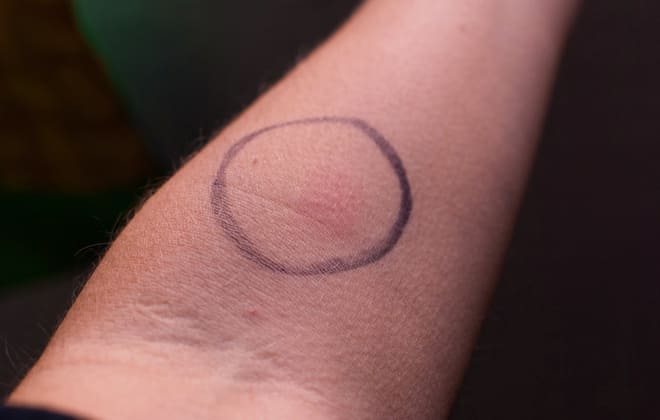
If there are no symptoms other than an enlarged papule, nothing should be done. Various healing creams can negatively affect the reaction. Cauterization with iodine, brilliant green and other means is prohibited.
If the child is tested for the first time, the minor is prone to allergic reactions, it is recommended to first give him antihistamines. To reduce the risk of a false result, allergens, products containing dyes, preservatives and other chemical additives should be temporarily excluded from the menu.
It is necessary to ensure that the child does not scratch the skin. The tissues adjacent to the injection site should be soft and not provoke allergic reactions.
If all the rules have been followed, but the papule turns out to be too large, the condition that has arisen should not be ignored. Additional examinations will be required.
What factors can affect the test result?
The accuracy of Mantoux depends on both external and internal factors. Thanks to them, a false positive result can be detected.
First of all, you need to know that injections with this test cannot be done if the child does not feel well, much less is in a painful state:
- temperature;
- he has a viral disease;
- there are chronic diseases of internal organs;
- There are bacterial infections in his body.
In addition to these diseases, a positive reaction can be provoked by the following reasons:
- dermatitis;
- poor nutrition;
- allergy to the active substance of the injection - tuberculin. In this case, the papule will increase in size in just 20 minutes;
- choosing the wrong time to perform the injection;
- child's age;
- getting the injection site wet or scratching it;
- processing the sample with detergents;
- increased sweating in the area where the papule is located.
Some mothers, in order to protect the injection site from getting wet, glue a patch on it or wrap it with a bandage and thereby provoke increased fogging of the child’s hand, which is reflected in the size of the “button”.
But a negative reaction also does not always show the whole situation. Babies under 6 months do not have a clear response to tuberculin, so it is used for children after one year. So a negative result is possible if the child became infected with tuberculosis within three months before the Mantoux test. In this case, a persistent reaction of the body will not yet have time to form. In children with congenital HIV infection, the papule will also not change in size. But these are special cases of diseases.
Proper care
To reduce Mantoux on the hand at home, it is recommended to exclude any factors that contribute to the occurrence of friction in the area where tuberculin was injected. Mechanical damage will lead to an increase in tumor growth. If the integrity of the papule is damaged, there is a risk of secondary infection. You should not cover this area of skin with a bandage for the same reason. Other manipulations that are not recommended:
- visit the bathhouse, sauna;
- treat the injection site with various means;
- rub the area of the hand where the papule is located with a washcloth;
- be exposed to sunlight for a long time;
- expose your hand to chemical or thermal effects;
- treat the skin with soap and other detergents;
- visit the pool (due to the chlorine content in the water);
- introduce unfamiliar foods into the diet, to which a negative reaction may develop.
Is it possible to smear
Before visiting a doctor to assess the condition of the papule, you should not treat the area of skin where tuberculin was injected. Sometimes this measure allows you to reduce the size of the tumor, but in most cases, if you anoint the papule, the condition of the skin worsens. The neoplasm increases in size. This is due to the irritating effect of any substance. To make the papule smaller, you can smear it with a wound healing agent, but only after examination by a doctor. If this is not done, the neoplasm will drag on longer.
Is it possible and how to reduce Mantoux
Mantoux can be reduced after a test only if the increase is associated with a nonspecific allergy, that is, not with infection with a tuberculosis infection. For children prone to allergic skin reactions, it is recommended:
- 3 days before and 2-3 days after Mantoux, take tablets (for example, Suprastin or Claritin);
- exclude from the diet foods that increase allergies (chocolate, nuts, sweets, honey, nuts, eggs);
- wear breathable clothes made of natural fabric with long sleeves (wool, synthetics, tight sweaters are not allowed);
- Avoid rubbing the injection site with a washcloth, towel, or getting detergents on it, applying any external medications, or covering with a band-aid.
If you simply anoint the papule to make it shrink, there is a risk of having the opposite effect. This reaction is explained by the fact that after the administration of tuberculin, T-lymphocytes are sent to the injection site. These cells of the immune system, when in contact with a tuberculosis bacillus, “remember” such an encounter. This can happen both during infection and after administration of the BCG vaccine. The size of the papule depends on the number of T lymphocytes.
Therefore, when applying the ointment, you can achieve a decrease in the intensity of redness, but it will not change the obvious positive reaction, and if the test is questionable, the assessment will be incorrect.
Is it worth reducing on the arm at home in the first 72 hours?
In the first 72 hours (before evaluating the sample), it is strictly forbidden to try to reduce Mantoux at home. If the test is assessed incorrectly, the child will not undergo the required examination on time. The doctor evaluates not only the current sample, but also necessarily compares it with last year’s, so the next diagnosis will also be affected.
It is also important for parents to know that even with an obvious positive or even hyperergic test (papule from 17 mm), the child will not be immediately diagnosed. An examination by a phthisiatrician, blood tests, and a chest x-ray will be scheduled.
This will help to identify the infection long before symptoms and undergo preventive treatment.
Evaluation of results
The injection is placed with a disposable special syringe on the inner side of the forearm. A dose of 2 TU is administered.
After the injection of tuberculin, a swelling immediately forms. These are leukocytes that are drawn to the introduced stimulus. After 2-3 days, the density of the papule and its size are assessed. Redness is only important when the papules are not visible at all. Any result other than negative is a reason for referral to a phthisiatrician.
There are several possible results:
- Positive. The papule is dense, ranging in size from 0.5 to 1.6 cm. Redness of the tissue is observed around it.
- Negative. The size of the papule is up to 0.1 cm, it is weakly expressed or almost invisible, there is no infiltration.
- Doubtful. Less than 0.4 cm, borders cannot be traced. There is a barely noticeable areola, no papules.
- Hyperergic. The size of the papules is more than 1.6 cm, along with this there is pronounced redness, skin changes in the form of ulcers, pustules, pimples. Sometimes there is a change in the color of the fabrics.
When assessing Mantoux, every millimeter is important. After all, not only the latest result is evaluated, but also its relationship with previous records. This means that immunity weakens in relation to resistance to tuberculosis. Virage is another reason to visit a TB doctor. Revaccination or preventative treatment may be needed.
How to prevent false results
To prevent a positive reaction from occurring in a healthy child, you should avoid exposure to ultraviolet radiation and various mechanical factors at the injection site, avoid visiting swimming pools, saunas and baths, introduce new foods to the diet before testing, and avoid getting chemical compounds on your hand.
If a child has recently been ill, suffers from dermatological pathologies, epilepsy, or hypersensitivity to the components of the drug used for testing, he should not be vaccinated, since the dimensions of the papule will be too large. There are other methods for checking the presence of tubercle bacilli in the body.
Fluorography can be performed. However, this study should not be carried out too often: radiation in large doses is harmful to health.
In some cases, Mantu is replaced with Diaskintest. When performing Diaskintest, you should not wet your hand during the first 24 hours; it is recommended to avoid getting water on the injection site until testing.
To check the correctness of the result, use the Pirquet test. Often, the features of the Pirquet test make it possible to identify the presence or absence of a disease if the Mantoux result is incorrect.
The Mantoux test is an effective means of diagnosing tuberculosis in children and adults, as well as a tool for monitoring the formation of immunity against this dangerous disease in children.
Experts recognize that thickening of the skin is significant ( after 72 hours
after tuberculin preparation was introduced into the body) measuring
more than 17 mm
in children and
21 mm
in adults.
This reaction is called hyperergic
and indicates the possibility of infection.
The size of the “button” after the Mantoux test may be considered too large in the case of a “turn” (compared to last year’s test, it has increased by more than 6 mm
).
In adults and adolescents who were vaccinated against tuberculosis (BCG) more than 5 years ago
, a negative reaction to tuberculin is considered the norm, so even a not very large papule after Mantoux
measuring 4 mm
is a sign of infection and the need for additional examination.
Mantoux test
Sanitary and epidemiological rules SP 3.1.1295-03 “Prevention of tuberculosis”, section V:
5.1. For the purpose of early detection of tuberculosis in children, tuberculin diagnostics are carried out on children vaccinated against tuberculosis from 12 months of age until they reach the age of 18 years. An intradermal allergy test with tuberculin (hereinafter referred to as the Mantoux test) is performed once a year, regardless of the result of previous tests.
5.2. The Mantoux test is performed 2 times a year:
- children not vaccinated against tuberculosis due to medical contraindications, as well as not vaccinated against tuberculosis due to parents’ refusal to immunize the child, before the child receives vaccination against tuberculosis;
- children with chronic nonspecific diseases of the respiratory system, gastrointestinal tract, diabetes mellitus;
- children receiving corticosteroid, radiation and cytostatic therapy;
- HIV-infected children.
5.4. It is not allowed to carry out the Mantoux test at home, as well as in children's and adolescent organizations during the quarantine period for infectious diseases. Mantoux tests are performed before preventive vaccinations.
5.5. The interval between preventive vaccination, biological diagnostic test and Mantoux test should be at least one month.
5.6. Within 6 days from the moment the Mantoux test is performed, the following categories of children are sent for consultation to the tuberculosis dispensary at their place of residence:
- with a newly detected positive reaction (papule 5 mm or more), not associated with previous immunization against tuberculosis;
— with a long-lasting (4 years) reaction (with an infiltrate of 12 mm or more);
- with increasing sensitivity to tuberculin in tuberculin-positive children - an increase in infiltrate by 6 mm or more;
- an increase of less than 6 mm, but with the formation of an infiltrate measuring 12 mm or more;
- with a hyperreaction to tuberculin - infiltrate 17 mm or more;
- with vesiculo-necrotic reaction and lymphangitis.
5.7. Children sent for consultation to a tuberculosis dispensary, whose parents or legal representatives have not submitted a phthisiatrician's conclusion about the absence of tuberculosis within 1 month from the date of the Mantoux test, are not allowed into children's organizations.
Children who have not undergone tuberculin diagnostics are admitted to the children's organization if they have a phthisiatrician's conclusion that they do not have the disease.
Conclusion
You can wet the injection site regardless of when you were given the injection and how much time has passed. The main thing during this period is to limit excessive contact with water, for example, going to the pool. After performing the injection, under no circumstances should you rub, comb or subject the injection site to other physical, thermal or chemical influences. If you neglected at least one of the points after the injection, be sure to tell your doctor.
If after three days the papule is less than 5 mm, then the result is negative. A tuberculin test of 10 mm indicates possible infection, and a 15 mm papule or the presence of blisters usually indicates infection with tuberculosis.
